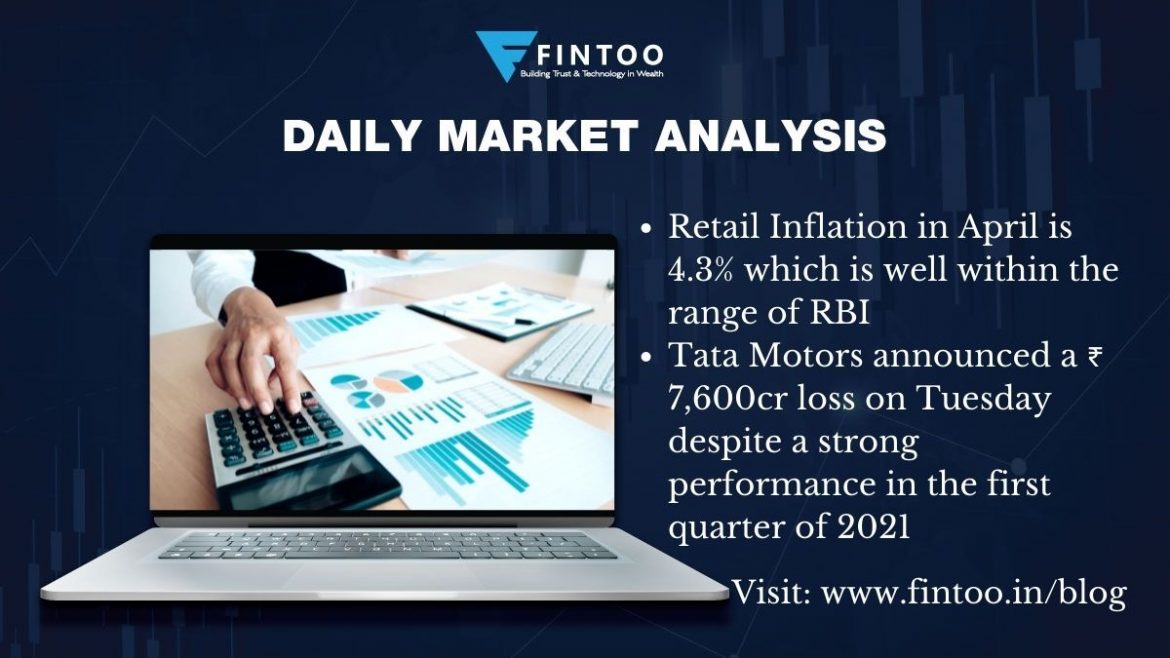

Inflation and its impact on an overall economy
Retail Inflation in April is 4.3% which is well within the range of RBI. Inflation is measured by the CPI and the wholesale price index (WPI). The CPI measures changes in prices of essential commodities at the consumer level, while the WPI notes changes at the producer level.
The commodities considered for measuring the WPI are manufactured products (63.75% weightage), primary articles such as food (20.02%), and fuel and power (14.23%).
For the CPI, the commodities are food and products (45.86%), housing (10.07%), clothing (6.53%), and fuel among others. Inflation is indicative of the decreasing purchasing power of the country’s currency and vice versa.
Inflation is indicative of decreasing purchase power of the country’s currency and vise versa.
It is basically the cost of production which is passed on to the consumers.
In the Monetary Policy Committee meeting of February 2021, Government specified that for the next 5 years they will not be focusing on maintaining the inflation rate. There is a possibility in the near future for the inflation rate to go higher.
In increasing inflationary conditions, the RBI adopts a contractionary monetary policy. In case of a slow-down, it adopts an expansionary monetary policy, which leads to the increased money supply, lower interest rates, lower borrowing costs, and increasing aggregate demand thereby giving a boost to the economy.
RBI has increased Gsec buying in the past 2 weeks
The central bank of India net purchased Rs. 34,175 crore of sovereign papers between April 22 and May 4 from the secondary market to ensure lower borrowing cost in the second wave that would derail the economic recovery.
The usual efforts through Open market Operation and Government Security Acquisition Program is a corrective measure that the government has been taking to control the rise in bond yields and lower the borrowing cost. The Government principal money manager is said to have bought T bills and long-term papers in 7 tranches in the past two weeks.
Due to the following action, the bond yields have reduced to 0.03 basis points to 6.02%.
Tata Motors Posts $1 billion loss as Jaguar Costs hot bottom line
Tata Motors announced a ₹ 7,600 crore ($1 billion) loss on Tuesday despite a strong performance in the first quarter of 2021 as restructuring costs related to its British luxury car brand Jaguar Land Rover (JLR) hit the automaker’s bottom line.
The company reported losses for three consecutive quarters last year, as the pandemic hammered demand in domestic and international markets.
The standalone business including joint operations reported profit at Rs 1,645.69 crore in Q4FY21 against a loss of Rs 4,871.05 crore in the year-ago quarter and clocked a massive 106 percent year-on-year growth in revenue at Rs 20,045.9 crore during the quarter, driven by strong passenger vehicle demand and recovery in commercial vehicle demand.
The commercial vehicle business consistently posted sequential quarter-on-quarter growth on the back of improved consumer sentiments, buoyancy in e-business, firming freight rates, and higher infrastructure demand including road construction and mining.
Also read: Best Tax Saving Instruments to Maximise Your Corpus – Fintoo Blog
WFH promotes tier 2 cities as talent hub and Unemployment in Rural India
Due to work from home policy tier, 2 cities like Kochi, Guwahati, Jaipur, Indore, and Mysore are said to have emerged as talent hubs.
According to Talent500, there has been a 30-40% increase in demand for workforce in tier-2 cities within tech teams across sectors.
Covid has made us all work remotely. In a post-pandemic world, remote won’t just be the new normal, but instead, be a strategic advantage for companies as they build out their teams.
On the other hand, we see rural unemployment has nearly doubled in a week as lockdowns and surging covid infections in villages brought economic activity to a halt. Rural unemployment shot up to 14.34%. The MSMEs (micro, small and medium enterprises) are in bad shape, and the informal jobs market, as well as self-employment in rural India. The situation may get worsened over the next few weeks if we don’t manage to tackle the pandemic in rural India.
Competition Commission of India (CCI) agreed to the proposal of acquisition of an additional 25% stake of Adani Krishnapatnam Port Ltd By Adani Port SEZ
Adani Port SEZ holds 75% shareholding; the proposed combination will lead to acquiring 100% shareholding and complete control.
In April, Adani Ports and Special Economic Zone had said it had acquired a 25 percent stake of Vishwa Samudra Holdings in Krishnapatnam Port for Rs 2,800 crore. Krishnapatnam Port, located on the east coast of India in the Nellore district of Andhra Pradesh, is an all-weather, deep water port with a multi-cargo facility with a current capacity of 64 million tonnes per annum.
12 Drugmakers and Healthcare companies are planning IPO in 2021
Covid-19 has increased investor demand for promising companies in sectors like Pharmaceuticals, healthcare, and related businesses that are beneficiaries of the pandemic.
In the past five years, only seven companies involved in the sector have hit the IPO
Companies like Glenmark Lifesciences, Supriya Lifesciences, Krsnaa Diagnostics, Krishna Institute of Medical Sciences KIMS, Tatva Chintan Pharma, Sigachi Industries Windlass Biotech have already filed their draft paper switch SEBI.
The four companies i.e Emcure Pharma, Wellness Forever, Vijaya Diagnostic, and Star Health Insurance have initiated the process for filing IPO.
It looks like there will be a massive change in the Indian Healthcare system because of covid -19 and demand for drugs, vaccines, diagnostic medical equipment, hospital, and other related services will increase over the period.
To Invest and keep regular track of your portfolio download: Fintoo App Android http://bit.ly/2TPeIgX / Fintoo App iOS http://apple.co/2Nt75LP
Related Posts
Stay up-to-date with the latest information.


